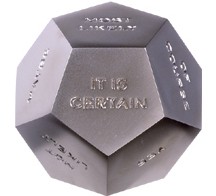A ten sided object (polyhedron) is known as a decahedron (three dimensional) while a ten sided two dimensional figure (polygon) is known as a decagon.
 Some examples of ten sided objects are a regular decahedron having all faces in the shape of a regular pentagon, an octagonal prism in the form of two octagons as bases on either sides and eight square faces, and nonagonal pyramid having ten faces in the form of nine triangles and a base in the shape of a nonagon.
Some examples of ten sided objects are a regular decahedron having all faces in the shape of a regular pentagon, an octagonal prism in the form of two octagons as bases on either sides and eight square faces, and nonagonal pyramid having ten faces in the form of nine triangles and a base in the shape of a nonagon.
Some decahedral shapes have been used as dice in certain games like Dungeons and Dragons and are much prized by dice collectors today. A regular decagon is a polygon with all ten sides equal in length and each of the ten interior angles equal in degree; each angle of a regular decagon measures 144 degrees and the sum of the angles is 1440 degree.
Some decahedral shapes have been used as dice in certain games like Dungeons and Dragons and are much prized by dice collectors today. A regular decagon is a polygon with all ten sides equal in length and each of the ten interior angles equal in degree; each angle of a regular decagon measures 144 degrees and the sum of the angles is 1440 degree.